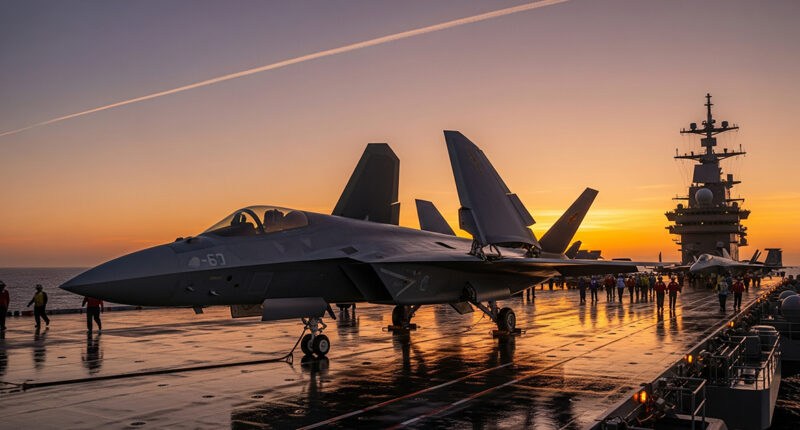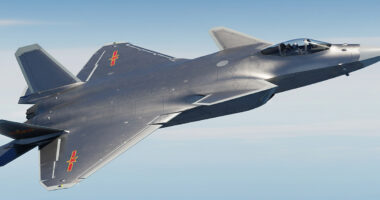The Dawn of a New Power: China’s Fifth-Generation Ambition
In the strategic competition for global influence, air superiority is the ultimate prize, and the key to unlocking it is the fifth-generation fighter jet. These advanced aircraft are defined by four core attributes: high maneuverability, supercruise capability, advanced sensor fusion, and, most critically, stealth or low observability. For decades, the United States maintained an undisputed technological edge in this domain with the introduction of the F-22 Raptor and later the F-35 Lightning II.
However, the landscape of air power is rapidly changing. China, through massive investment and targeted development, has introduced its own suite of cutting-edge platforms. First came the J-20, a heavy air superiority fighter. Now, the spotlight is firmly on the Shenyang J-35 (sometimes referred to as the FC-31’s operational variant), a medium-sized, twin-engine stealth fighter designed with a crucial, specific mission: carrier-based operations.
China’s state media, particularly the omnipresent CCTV, has been bold in its pronouncements, claiming the J-35 possesses a stealth capability so refined that it presents a profound challenge to established Western air dominance. This jet is more than just a piece of hardware; it is a symbol of Beijing’s growing technological competence and its aspiration to become a peer competitor on the global stage.
The Science of Subtlety: Decoding Radar Cross Section (RCS)
To understand the J-35’s alleged power, one must first grasp the concept of Radar Cross Section (RCS). RCS is a measure of how detectable an object is by radar. It is not the physical size of the aircraft but the size of a hypothetical, perfectly reflective sphere that would return the same amount of radar energy. A smaller RCS means a more effective stealth aircraft.
A common misconception is that stealth jets are “invisible.” They are not. Instead, they employ a trifecta of technologies to minimize their RCS:
- Shaping: The aircraft’s exterior is designed with complex, faceted angles that deflect incoming radar waves away from the receiver.
- Materials: Specialized Radar-Absorbent Material (RAM) coating is used to absorb a significant portion of the radar energy that hits the airframe, converting it into heat rather than reflecting it.
- Internalization: Weapons, fuel, and sensors are kept inside internal bays to avoid the highly reflective surfaces of external stores.
The J-35’s design, which appears to utilize twin oblique tail fins and a diamond-like fuselage cross-section, clearly adheres to these principles.
The ‘Handful of Stealth’ Claim vs. Global Benchmarks
CCTV has generated significant controversy and intrigue by suggesting the J-35’s stealth capability is extraordinary, going so far as to claim its total RCS is equivalent to the size of a human palm. While the official RCS values for any fifth-generation fighter are classified secrets, analysts use official statements, design features, and observable data to create working estimates.
The Chinese media reports hint that the J-35’s RCS could be as low as 10 to 100 square centimeters (sq.cm). They argue that if detected, a radar operator would likely dismiss the signature as a large bird or drone, not a heavy fighter jet, because the RCS is smaller than what is typically expected of a military aircraft.
To put this claim into context, we must compare it with the current benchmarks:
- US F-22 Raptor: Widely considered the stealthiest jet in existence, its RCS is estimated to be below 1 sq.cm (the size of a small marble or pebble). It represents the absolute pinnacle of low observability.
- US F-35 Lightning II: A multirole fighter, its RCS is estimated at approximately 15 sq.cm (the size of a golf ball), a highly respectable figure that defines the modern standard.
- China J-20: China’s first stealth jet, a larger design focused on air superiority, is estimated to have an RCS likely between 100 and 1,000 sq.cm.
If the J-35 can consistently achieve an RCS near the 10-15 sq.cm mark, it would indeed place it in the same league as the F-35. However, the data suggests it does not surpass the legendary, yet technologically older, F-22 Raptor. The J-35 is thus challenging the global stealth standard, but is likely not yet the most stealthy aircraft in the world.
Strategic Power Projection: The Carrier-Based Mission
The J-35’s ultimate significance is not purely in its RCS number, but in its ability to operate from the deck of an aircraft carrier. The jet is designed to launch and recover from a CATOBAR (Catapult Assisted Take-Off Barrier Arrested Recovery) system, making it the perfect complement to China’s new, advanced carriers.
The J-35’s successful completion of carrier landing and take-off exercises has made it only the second stealth fighter globally capable of fully integrating with carrier operations, following the US F-35B (STOVL) and F-35C (CATOBAR).
This capability directly ties into China’s growing naval ambitions. The third, and largest, Chinese carrier, the Fujian, is currently undergoing sea trials. The introduction of the Fujian, which will utilize an electromagnetic catapult system (EMALS) akin to the US Navy’s most advanced carriers, will allow it to efficiently launch the J-35. The combination of a powerful, modern carrier and a fleet of stealth fighters exponentially increases China’s ability to project power far from its mainland—a direct challenge to the US presence in the Western Pacific.
The J-35 is slated to operate alongside the updated fourth-generation J-15T, but it will be the spearhead of the carrier air wing, tasked with penetrating enemy defenses and establishing air dominance.
The Race Continues: Beyond the Hype
While the J-35 represents a major leap for Chinese military aviation, the true test of its stealth and combat effectiveness remains a mystery. Both the US and China are fiercely secretive about the proprietary stealth coatings and electronic warfare systems of their fifth-generation assets. Furthermore, the F-22 and F-35 benefit from decades of operational deployment and integration with a massive global military ecosystem.
The J-35 is a powerful statement of intent. It proves that China can develop, build, and deploy world-class stealth technology for both land and sea-based operations. As the J-35 and the Fujian carrier enter full operational status, military analysts worldwide will be watching closely. The aerial balance of power over the South China Sea and the Pacific is shifting, and the ‘handful of stealth’ may soon be firmly clutched in the hand of a new superpower.









